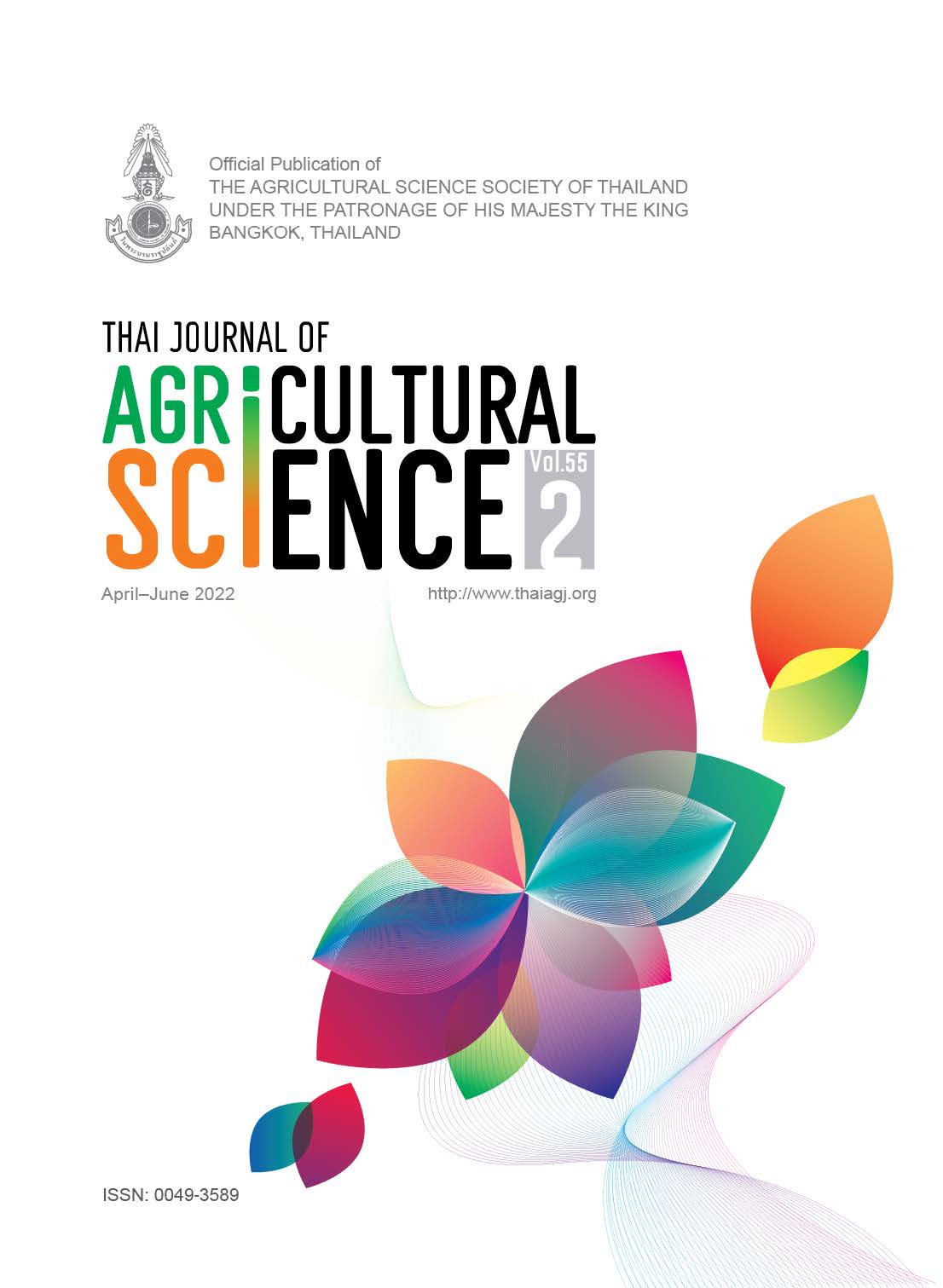Effects from feed restriction and/or dietary inclusion of vitamin E in primiparous rabbits on growth performances and gestation period
Main Article Content
Abstract
Replacement rabbit does can be given restricted amount of feed until their first mating or parturition, this is necessary in order to avoid excessive fattening, higher perinatal mortality, low voluntary feed intake during early lactation, and shorter reproductive life of does. Thus, this study aimed to evaluate the effect of quantitative feed restriction at different gestation periods with or without vitamin E inclusion on the performance of pregnant rabbit does. Sixty (60) rabbits of 5 months old weighing between 1.7–2.0 kg were randomly assigned into 12 treatments of 5 replicates each. The rabbit does were divided into two groups and placed on two levels of quantitative feed restriction (0% and 15%) at three periods of gestation (15–19, 20–24, and 25–29 days) with or without vitamin E inclusion in their diet (0 and 300 mg/kg). Data obtained on feed intake, weight gain, feed conversion ratio and gestation length of the rabbit does were subjected to analysis of variance using a 2 × 3 × 2 factorial in a completely randomized design. Feed restriction at 15% increased the gestation length (31.20 ± 0.96 days) of rabbit does compared to the ad libitum (30.10 ± 0.30 days) fed groups. Gestating rabbit does on feed restriction at 25–29 days of gestation had longer gestation length (31.25 ± 1.16 days) than rabbit does on restriction at 15–19 days (30.40 ± 0.60 days) and 20–24 days (30.30 ± 0.47 days). Vitamin E supplementation did not influence the measured parameters. Final weight, weight gain, and feed conversion ratio were not affected by the levels and periods of feed restriction with or without vitamin E supplementation. Therefore, it can be concluded that feed restriction does not have any detrimental effect on final weight, weight gain, and feed conversion ratio of gestating rabbit does.
Article Details

This work is licensed under a Creative Commons Attribution-NonCommercial-NoDerivatives 4.0 International License.
References
Abdel-Khalek, A.M., N.A. Selim, Sh. A. El-Medany and S.A. Nada. 2008. Response of doe rabbits to dietary antioxidant vitamins E and C during pregnancy and lactation, pp. 519–524. In: Proceedings of the 9th World Rabbit Congress, 10–13 June 2008, Verona, Italy.
Adeyinka, I.A., C.L. Akanwa, G.T. Iyeghe-Erakpotobor, F.D. Adeyinka and M. Orunmuyi. 2007. Factors affecting some traits of economic importance in rabbits in a tropical environment of northern Nigeria. J. Biol. Sci. 7: 425–428.
Aduku, A.O. and J.O. Olukosi. 1990. Rabbit Management in the Tropics, Production, Processing, Utilization, Marketing, Economics, Practical Training, Research and Future Prospects. Living Books Series GU Publications, Abuja, Nigeria.
Bowen, R. 2003. Vitamin E. VIVO Pathophysiology. Available Source: http://www.vivo.colostate.edu/hbooks/pathphys/topics/vitamine.html.
Ebeid, T.A., H.S. Zeweil, M.M. Basyony, W.M. Dosoky and H. Badry. 2013. Fortification of rabbit diet with vitamin E or selenium affects growth performance, lipid peroxidation, oxidative status and immune response in growing rabbits. Livest. Sci. 155(2–3): 323–331.
Eiben, C., K. Kustos, Á. Kenessey, G. Virág and Z. Szendrő. 2001. Effect of different feed restrictions during rearing on reproduction performance in rabbit does. World Rabbit Sci. 9(1): 9–14.
El-Speiy, M.E., K.I. Kamel, A.E. Tag El-Din, A.E. Abd El-Hamid and A.M E. EL-Kamhawey. 2015. Effect of feed restriction on productive performance, carcass yield, blood pictures and relative organ weights of growing rabbits. Egypt. Poult. Sci. J. 35(2): 439–454.
Google Earth. 2018. Federal University of Agriculture. Arailable Source: http://earth.google.com/web/. March 1, 2018.
Krieger, T. and R. Loch-Caruso. 2001. Antioxidants prevent gamma-hexachlorocyclohexane-induced inhibition of rat myometrial gap junction and contractions. Biol. Reprod. 64(2): 537–547.
Maertens, L. 1992. Rabbit nutrition and feeding: a review of some recent developments. J. Appl. Rabbit Res. 15: 889–890.
Manal, A.F., M.A. Tony and O.H. Ezzo. 2010. Feed restriction of pregnant nulliparous rabbit does: consequences on reproductive performance and maternal behaviour. Anim. Reprod. Sci. 120: 179–186.
Partridge, G.G., Y. Daniels and R.A. Fordyce. 1986. The effects of energy intake during pregnancy in doe rabbits on pup birth weight, milk output and maternal body composition change in the ensuring lactation. J. Agric. Sci. 107(3): 697–708.
Rasmussen, K.M. 1998. Effects of under- and overnutrition on lactation in laboratory rats. J. Nutr. 128(2): 390S–393S.
Rizzi, C., G.M. Chiericato and A. Dalle. 2008. Reproductive and physiological responses of rabbit does under different nutritive levels before the first parturition, pp. 437–441, In: Proceedings of the 9th World Rabbit Congress, 10–13 June 2008, Verona, Italy.
Rommers, J.M., B. Kemp, R. Meijerhof and J.P.T.M. Noordhuizen. 1999. Rearing management of rabbit does: a review. World Rabbit Sci. 7(3): 125–138.
Rommers, J.M., B. Kemp, R. Meijerhof and J.P.T.M. Noordhuizen. 2001. The effect of litter size before weaning on subsequent body development, feed intake, and reproductive performance of young rabbit does. J. Anim. Sci. 79(8): 1973–1982.
Salem, A.A. and Y.A. Gomaa. 2014. Effect of combination vitamin E and single long-acting progesterone dose on enhancing pregnancy outcomes in the first two parities of young rabbit does. Anim. Reprod. Sci. 150(1–2): 35–43.
Szendrö, Zs., Gy. Mihálovics, G. Milistis, E. Biró-Németh and I. Radnai. 2000. Effect of reduction of feeding time on the performances and carcass quality of growing rabbits, pp. 459–465. In: Proceedings of the 7th World Rabbit Congress, 4–7 July 2000, Valencia, Spain.
Tůmová, E., M. Skřivan, V. Skřivanová and L. Kacerovská. 2002. Effect of early feed restriction on growth in broiler chickens, turkeys and rabbits. Czech J. Anim. Sci. 47(10): 418–428.
Tůmová, E., V. Skřivanová and M. Skřivan. 2003. Effect of restricted feeding time and quantitative restriction in growing rabbits. Arch. Geflügelk. 67(4): 182–190.


